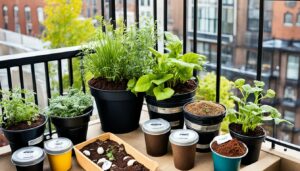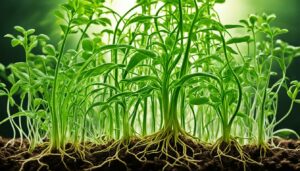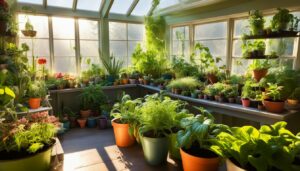Did you know that a mere one-point shift in soil pH can lead to a tenfold change in soil acidity or alkalinity? This seemingly minor detail has major implications for plant health—raising the stakes for accurate soil pH testing and precise adjusting of soil chemistry. For gardeners, this knowledge isn’t just useful, it’s essential to cultivate a vibrant and healthy garden.
The proper balance of soil pH is a delicate dance that influences a plant’s ability to absorb nutrients—a dance that gardeners must master to ensure their soil chemistry promotes robust plant health. The journey from novice to green-thumbed soil expert begins with a simple but crucial step: understanding and managing soil pH.
Whether dabbling in soil pH testing, considering adjusting soil pH, or delving into the detailed aspects of soil chemistry for gardeners, every decision can have a cascading effect on the well-being of your plants. Let’s explore the remarkable world beneath our feet, where the pH level reigns supreme as the hidden conductor of garden vitality.
Key Takeaways for Plant Health Through Soil pH Mastery
- Soil pH significantly influences nutrient availability—a critical component of plant health.
- Understanding the pH scale and its impact on soil chemistry is vital for gardeners.
- Regular soil pH testing is a necessary practice for the proactive gardener.
- Adjusting soil pH requires knowledge, patience, and the right amendments or techniques.
- Optimal soil pH is typically between 6 and 7; however, specific plants may require adjustments.
- Toxicity from incorrect pH levels can hinder growth and increase disease susceptibility.
- Effective soil pH management can lead to a more flourishing and sustainable garden.
Introduction to Soil pH and Garden Ecosystems
At the heart of successful gardening lies the importance of soil pH for gardening, an indicator vital to understanding the health and potential of our green spaces. The chemistry of the soil, an intricate tapestry woven with elements and compounds, hinges on the measure of hydrogen ion concentration—otherwise known as soil pH. The comprehension of this facet of soil chemistry is not a mere academic pursuit but a practical necessity for ensuring the vigorous growth and sustainability of our gardens.
As soil pH sways from acidic to alkaline, so too does its capacity to sustain various forms of plant life. Within acidic settings, an abundance of micronutrients becomes more accessible to plants, nurturing their development. Contrastingly, alkaline soils may hinder roots from absorbing pivotal nutrients such as phosphorus, thereby posing a challenge to gardeners striving to optimize their ecosystems. Recognizing the soil pH testing methods becomes the gardener’s compass, directing them through the complex terrain of soil management.
- Acidic soils (pH < 7): Enhance the solubility of micronutrients like iron and manganese, essential for the growth of certain plant species.
- Neutral soils (pH = 7): Support a balanced nutrient availability, catering to a wide range of plant preferences.
- Alkaline soils (pH > 7): May restrict the absorption of nutrients, necessitating a tailor-made approach to fertilization and plant selection.
The ins and outs of understanding soil chemistry draw a map for gardeners to cultivate an environment where plants not only survive but thrive. Biomass volume, floral opulence, and the success of seed propagation all dance to the tune of soil pH. Interestingly, the resilient nature of alien plant species is often linked to their adaptive responses to varying soil pH levels, affecting biodiversity and ecosystem functionality. In contemplating this dance of chemistry and nature, we come to appreciate the foundational role of soil pH and its testing in the art and science of gardening.
Understanding Soil pH Levels and Plant Nutrient Availability
Knowing the intricacies of soil pH is crucial for gardeners looking to optimize their garden’s productivity and health. Soil pH, which stands for the ‘potential of Hydrogen,’ essentially determines the acidity or alkalinity of the soil, greatly influencing plant nutrient availability. Employing the best practices for soil chemistry for gardeners is not just beneficial but necessary for a thriving garden.
Defining Soil pH and Its Scale
A fundamental aspect of soil chemistry for gardeners is understanding the pH scale, which ranges from 0, indicating extreme acidity, to 14, indicating extreme alkalinity, with 7 being neutral. If your goal is optimizing soil pH levels, a good grasp of this scale is essential as it directly impacts the concentration of nutrients in your soil.
How pH Affects Nutrient Uptake in Plants
Plants absorb nutrients from the soil, which is a process heavily influenced by soil pH. Alterations in soil acidity or alkalinity can facilitate or hinder the uptake of critical nutrients, making tips for adjusting soil pH an integral component of garden management. For robust plant growth, a pH balance that allows these nutrients to be soluble and available to plants is key.
Ideal pH Ranges for Different Types of Plants
While most common garden plants thrive in a soil pH close to neutral, specialized varieties such as blueberries and azaleas might require more acidic conditions. Conversely, plants like lavender and asparagus favor a touch of alkalinity. Here, knowledge of acidifying soil for specific plants becomes invaluable.
Table: Optimal Soil pH Levels for Common Garden Plants
| Plant Type | Ideal pH Range |
|---|---|
| Azaleas | 4.5 – 6.0 |
| Blueberries | 4.0 – 5.5 |
| Potatoes | 4.8 – 6.5 |
| Lavender | 6.5 – 7.5 |
| Asparagus | 6.5 – 8.0 |
Leveraging the knowledge of soil pH levels and the pH scale, gardeners can undertake how to test soil pH accurately, aiming to create the most conducive environment for desired plant species. This will prompt the need for occasional interventions, employing tips for adjusting soil pH, like adding lime to raise the pH or introducing sulfur to lower it, thereby ensuring your plants receive the right balance for their nutrient requirements.
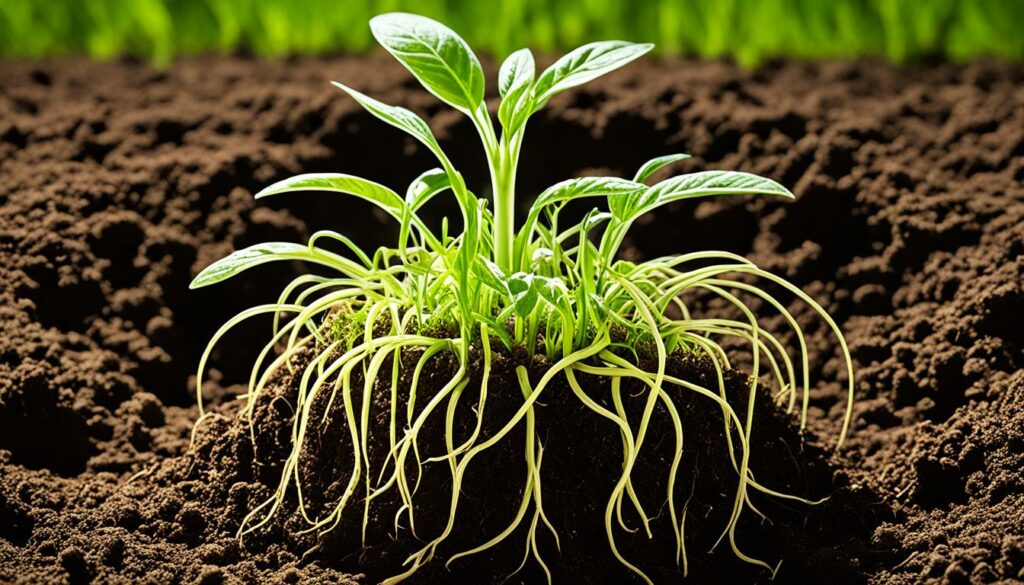
In conclusion, mastering the skill of how to test soil pH and utilizing methods to adjust soil pH will significantly improve the health of your garden. With a nuanced approach to soil chemistry for gardeners, even the most delicate of plants can flourish under your care. Whether you’re looking to maintain lush green foliage or cultivate bountiful produce, success lies in the pH!
Methods for Soil pH Testing and Analysis
Ensuring the health of your garden begins with understanding the soil in which your plants grow. One of the best practices for soil pH testing is to utilize reliable soil pH test kits available from garden centers. These kits often involve a straightforward process of adding a soil sample to a specified solution and subsequently measuring the pH by color comparison.
Different Types of Soil pH Tests
Aside from home kits, gardeners can seek a more thorough analysis by contacting their local County Extension agent for a soil test. This professional evaluation not only verifies the soil’s pH with precision but also provides specific recommendations for maintaining the optimal pH level for your crops.
Interpreting Soil pH Test Results
After obtaining soil pH test results, accurately interpreting soil pH is critical. The colorimetric method, although qualitative, offers rapid insight into whether your soil is more acidic or alkaline. Detailed analysis from a County Extension agent, however, will equip you with exact figures, granting you the ability to make well-informed decisions on soil amendments tailored to your garden’s needs.
When to Test Your Garden’s Soil
Timing is essential when considering when to test soil pH. Seasonal soil pH variation can influence the decision-making process for amending your garden. It is generally advised to conduct testing before planting or after the introduction of any fertilizers to the soil to ensure that the pH levels are conducive to plant health. Periodic monitoring can also detect any significant changes and help maintain the desired soil pH balance throughout the growing season.
| Testing Method | Best Use | Ideal Timing |
|---|---|---|
| Home Test Kits | Quick and easy pH indication | Before planting season |
| County Extension Test | Detailed soil analysis | Annually, or after major soil amendments |
| Professional Lab Analysis | Comprehensive nutrient profiling | Before initiating a long-term planting plan |
Ultimately, employing the right soil pH testing method, at the right time, is a foundational step in fostering a vibrant and healthy garden. Whether you’re a hobbyist or a professional grower, taking the time to understand and react to the complexities of soil chemistry can yield significant dividends in plant health and productivity.
Adjusting Soil pH for Optimal Plant Health
Creating the ideal soil environment is crucial for any gardener looking to ensure the health and vigor of their plants. Altering the pH of garden soil can make a significant difference in plant growth, nutrient uptake, and overall garden success. By implementing the right strategies and methods, gardeners can adjust soil acidity or alkalinity to meet the specific needs of their plants.
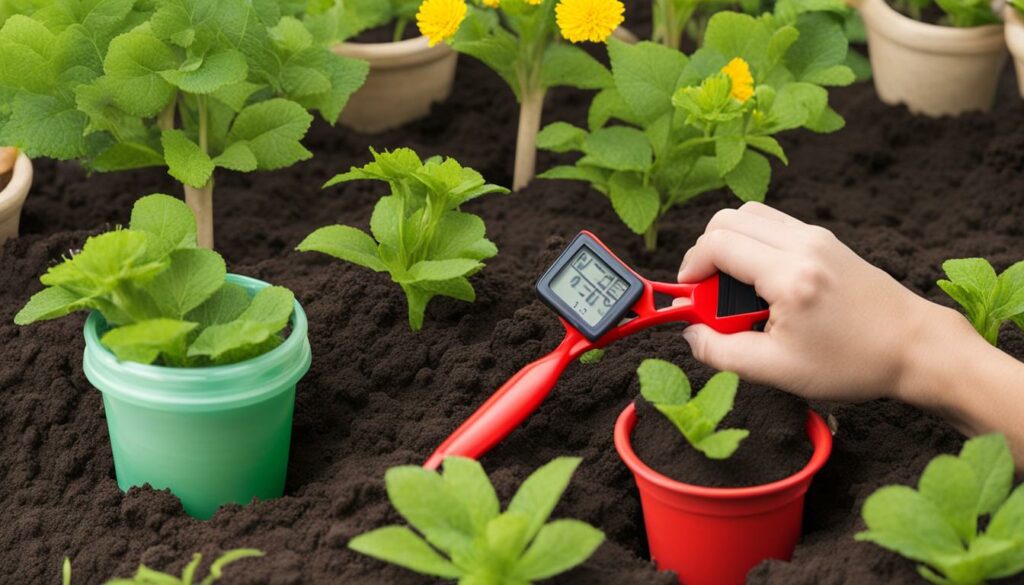
Strategies for Increasing Soil Alkalinity
When it comes to how to make alkaline soil, one of the most common methods is using lime to increase soil pH. Lime is an invaluable resource for gardeners aiming to moderate their soil’s acidity levels. It is important to note that the time frame for liming to take effect varies and patience is key.
Methods for Acidifying Soil
Conversely, for those pondering how to make soil more acidic, there are several effective substances. Among these, using elemental sulfur to acidify soil stands out as a method that works in harmony with soil microbes and results in a more controlled pH change over time.
Organic Approaches to Adjust Soil pH
In an era where ecological preservation is paramount, organic soil acidification methods are becoming increasingly popular. These provide a sustainable way to manage soil acidity organic solutions, encouraging healthy plant growth and protecting the surrounding ecosystem.
| Amendment | Effect on Soil pH | Application Method | Usage Notes |
|---|---|---|---|
| Agricultural Lime | Increases alkalinity | Spread evenly over soil | Particle size affects rate of pH change |
| Elemental Sulfur | Lowers pH | Applied to soil surface and watered in | Microbial action required for pH shift |
| Organic Material | Depends on material acidity | Mixed into the soil | Gradual alteration, improves soil structure |
soil pH testing, adjusting soil pH, soil chemistry for gardeners
Understanding the importance of soil pH testing is essential for gardeners who want to optimize plant growth and maintain the soil chemistry of their gardens. Soil pH levels have a direct effect on nutrient availability and can drastically influence plant health. Accurate soil pH testing reveals whether the soil is acidic, neutral, or alkaline, providing gardeners with the information they need to make crucial adjustments.
Adjusting soil pH can seem complex, requiring patience and precision. Gardeners must familiarize themselves with the various materials and methods to effectively alter the pH to suit their specific plants’ requirements. Here are some tips for adjusting soil pH to achieve the desired balance:
- Test your soil pH regularly to monitor any fluctuations that may affect plant health.
- Use lime to gently raise the pH of acidic soils, improving conditions for plants that prefer a more alkaline environment.
- For acidifying soil, elemental sulfur can be utilized, which microbes in the soil will slowly convert into acid, thereby lowering the pH level over time.
- Incorporate organic materials like peat moss, which can naturally lower soil pH, providing an organic solution for acidification.
Understanding and amending your garden’s soil chemistry is not only about achieving an immediate result but also about ensuring the long-term health and fertility of your garden beds. The table below provides a quick reference for the materials commonly used in pH adjustment and their typical applications:
| Material | Effect on Soil pH | Typical Application |
|---|---|---|
| Lime (Calcium carbonate) | Increases pH (making soil more alkaline) | Applied to acidic soils to neutralize pH |
| Sulfur | Decreases pH (making soil more acidic) | Used in alkaline soils to lower pH gently over time |
| Peat Moss | Decreases pH (acidifying) | Mixed into soil for plants preferring acidic conditions |
| Wood Ash | Increases pH (adding alkalinity) | Light application in gardens to moderately raise soil pH |
Whether you are tending to a vegetable garden, ornamental flowers, or a lush green lawn, soil pH testing and adjusting become indispensable endeavors to ensure your soil provides the ideal environment for your plants. With the right knowledge and tools, you can create a thriving garden that’s both beautiful and bountiful.
Long-Term Soil Health and Maintenance Practices
Maintaining the delicate balance of soil pH is essential for a thriving garden and robust plant root development. Long-term soil health hinges on consistent pH regulation, strategic applications of lime, and the integration of organic matter that collectively foster an environment ripe for garden success.
Best Practices for Maintaining Proper Soil pH
Keeping soil pH at the sweet spot necessary for your plants involves a vigilant approach to soil chemistry monitoring. Regular soil testing is the guidepost for whether liming to correct soil pH is needed. Given that soil composition and agricultural practices can vary drastically, so too does the liming frequency and quantity required. Achieving and preserving optimal pH is not a one-time event but a continual process pivotal to soil health.
Role of Organic Matter in Soil pH Regulation
Organic matter contributes more than just nutrients to your soil. It plays an indispensable role in moderating soil pH, acting much like a natural buffering agent. The addition of organic materials can enhance microbial activity, leading to a cascade of benefits from improved soil structure to effective nitrogen fixation—all promoting a balanced soil pH conducive to vital plant growth.
Monitoring Soil Chemistry for Garden Success
Persistent monitoring of soil chemistry is not just for scientific interest—it’s a practical necessity for garden success. Changes in soil pH affect everything from nutrient uptake to the presence of soil-dwelling organisms that benefit your plants. By keeping a close eye on soil pH and other chemical factors, gardeners can act promptly to rebalance soil conditions, ensuring that your plants have the environment they need to thrive.
Embracing these principles of pH regulation and soil health is fundamental for long-term success in gardening. Whether you’re liming your lawn to amend acidic soil or integrating rich organic matter to maintain pH balance, these efforts culminate in a flourishing garden ecosystem where plants can reach their full potential.
Conclusion
The lynchpin for a flourishing garden truly lies beneath our feet, in the realm of soil chemistry where the soil pH balance holds sway. A keen awareness of pH levels and their direct impact is essential for gardeners pursuing the zenith of garden ecosystem health. Intricately woven into every facet of horticulture, soil pH governs the availability of nutrients that are essential for robust plant growth and resilience against diseases.
By embracing best practices such as conducting regular soil tests and adjusting pH levels as needed, gardeners can significantly enhance the prosperity of their gardens. The strategic interplay of soil amendments and the judicious integration of organic material can effectively calibrate the soil environment, leading to a vigorous garden that thrives season after season. These efforts do more than yield immediate results; they are investments in sustaining the robustness of our green spaces.
Ultimately, the conscientious gardener who masters the intricate dance of soil pH management is rewarded with vibrant plants and generous harvests. Such dedication not only satiates the soul with visual beauty and abundant produce but also fortifies the practice of sustainable gardening—an enduring legacy that nourishes both the earth and our future.



